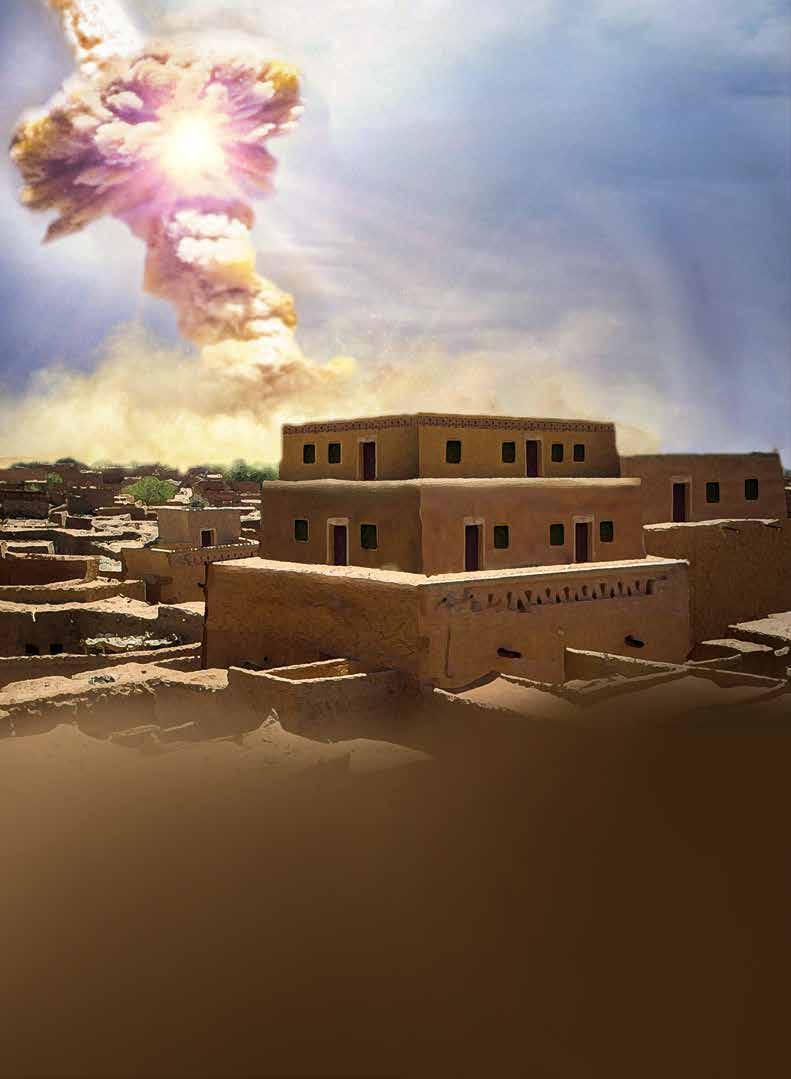
22 minute read
What If Sodom Has Been Found?
What If SODOM
Has Been Found?
Advertisement
Fifteen seasons of excavation at an enormous archaeological site in the Jordan River Valley have yielded remarkable evidence of an ancient city-destroying cataclysm. Could this be proof of the biblical story of Sodom? What does it mean for us today?
Astory of “biblical proportions”—having huge ramifications—was recently announced and picked up by various news outlets across the country and around the world.
For the last 16 years archaeologist Dr. Steven Collins, executive dean at Albuquerque’s Trinity Southwest University, and a team of staff and volunteers have been excavating a site they believe to be biblical Sodom. The excavation site is on the east side of the Jordan Valley in the nation of Jordan, across the Jordan River from Jericho. The site is huge—easily four to five times the size of Jericho, which existed at the same time.
Through the course of their excavations (digging in January and February, when the temperatures are mild enough to make digging tolerable) some very exciting scientific discoveries have been made.
In recent dig seasons Dr. Collins and his team have found evidence of overwhelming destruction at this place now called Tall el-Hammam. For years Dr. Collins has been presenting evidence for why he thinks this is the most probable site for the ancient city of Sodom (see “The
by Peter Eddington

Location of Sodom: What Does the Bible Say?” beginning on page 11).
Another key member of the excavation team is Dr. Phillip Silvia, a field archaeologist and supervisor with the Tall el-Hammam Excavation Project (TeHEP). This past autumn a scientific, peer-reviewed 65-page research paper—authored by 21 scientists, including Dr. Silvia—was released to scientific journals around the world. The initial publication was in Nature Scientific Reports.
What is striking about the paper is that it details how destruction evidence found by the archaeologists at Tall el-Hammam fits the biblical description of Sodom’s sudden end. The evidence shows a sudden catastrophic destruction
originating outside of this planet.
Our Beyond Today editorial staff have been following these excavation efforts for the last 16 years, even visiting the site shortly before excavations started in 2005. We should note that we do have some dating issues with this site, as our understanding of the chronology of the time in which Abraham lived and Sodom was destroyed places the destruction of the city around 200 years earlier than what the site’s excavators have concluded.
The Tall el-Hammam team is confident that its dating of the site is accurate. At present there’s no easy answer for the discrepancy. Perhaps more will come to light in the coming months and years to bring us all closer together on the date of this city’s destruction. Biblical archaeology is an ever-evolving scientific field as new evidence is continually emerging in the lands of the Bible.
Several reputable archaeologists have also concluded this is indeed the site of Sodom, in spite of the dating issues. Evidence from the site itself, as well as biblical location markers, is very compelling. The geographical
evidence and new scientific evidence of the city’s destruction present a very strong case.
The story has deep biblical implications for the archaeological community, but far deeper spiritual implications for the entire world.
Let’s look, then, into the Scriptures to see what happened to the cities of Sodom and Gomorrah and compare that to what scientists have discovered. And with that background let’s consider the question, What if Sodom has been found? What does it mean for humanity? And what should it mean to you and me personally?
Sodom: a cesspool of wickedness
Most of us are probably familiar with the biblical account of the destruction by God of Sodom and Gomorrah because of the sins of the people. Only a tiny handful of residents escaped. Abraham pleaded with God to spare the city if even a few righteous people could be found there (Genesis 18:16-33). Only Abraham's nephew Lot and his family were worthy to be spared, these because of their connection to righteous Abraham. The people of Sodom were prideful and affluent with abundant food and idleness and with no care for the needy as they brazenly descended into increasing abomination, leading to God sending destruction (Ezekiel 16:49-50).
The story of that destruction is recorded in Genesis 19. The introduction to the depravity of the city is quite shocking. Two angels in human form come to the city to rescue Lot and his family from the coming destruction. Lot gives them a safe place to stay for the night in his home, but the story quickly takes a dark turn, with the men of the city surrounding the house to gang-rape the visitors! (verses 4-5).
Lot pleaded with them, “Please, my brethren, do not do so wickedly!” (verse 7). Lot even offered the mob his two daughters, but they threatened him and nearly broke down his door before the angels rescued him by striking the crowd with blindness (verses 8-11).
It’s from this account that the term sodomy entered the English language. Outlawed in most countries for many centuries, it’s now approved and widely accepted, with those still
The findings at Tall el-Hammam have deep biblical implications for the archaeological community, but far deeper spiritual implications for the entire world. The half-mile-long mound of Tall el-Hammam lies at the edge of the Jordan River Valley. It was at the heart of a huge ancient city destroyed in a cataclysm that appears remarkably like the biblical story of Sodom.
viewing it as sinful themselves condemned and denounced as backward bigots.
Fiery destruction from the sky
The story doesn’t end there. The angelic messengers tell Lot to gather his family and flee—“For we will destroy this place, because the outcry against them has grown great . . . , and the Lord has sent us to destroy it” (verse 13).
Lot pleaded with his sons-in-law, telling them, “Get up, get out of this place; for the Lord will destroy this city!” (verse 14). But they took it as a joke and refused to heed. After all, Sodom was a large and prosperous city—there was nothing to worry about, right?
As morning dawned, the angels urged Lot to hurry and take his wife and daughters out of the city. As he lingered, the angels took his hand and the hands of his family members and literally pulled them out of the city. There one of the angels told them: “Escape for your life! Do not look behind you nor stay anywhere in the plain. Escape to the mountains, lest you be destroyed” (verse 17).
When they made it to the outlying town of Zoar, all hell broke loose.
“Then the Lord rained brimstone and fire on Sodom and Gomorrah, from the Lord out of the heavens. So He overthrew those cities, all the plain, all the inhabitants of the cities, and what grew on the ground” (verses 24-25). The cities, nearby towns and villages, their inhabitants and even the crops and trees were obliterated.
Abraham, far from the danger zone yet close enough to realize a catastrophe had taken place, “looked toward Sodom and Gomorrah, and toward all the land of the plain; and he saw, and behold, the smoke of the land which went up like the smoke of a furnace” (verse 28).
The area that previously had been so lush and verdant as to be compared to the Garden of Eden and fertile Egypt (Genesis 13:10) was now a scene of smoldering, smoking desolation. Sodom, Gomorrah and the surrounding towns and villages were gone, reduced to rubble and ashes from the fiery blast.
The case for a cosmic airburst
Is there any correlation between what scientists have recently discovered and the biblical passages we’ve just read?
On Sept. 20, Dr. Phillip Silvia, director of scientific analysis for the Tall el-Hammam Excavation Project, announced the publication of the earlier-mentioned paper in Nature Scientific Reports titled “A Tunguska Sized Airburst Destroyed Tall el-Hammam, a Middle Bronze Age City in the Jordan Valley Near the Dead Sea.”
It provides detailed forensic evidence that a cosmic airburst obliterated Tall el-Hammam, the largest city in the Dead Sea area for centuries before or after, an event they date at around 1650 B.C.
Tall el-Hammam excavation director Dr. Steven Collins has long proposed the site as the most likely candidate for the biblical city of Sodom. It’s in the right place, based on many geographical clues in Genesis (again, see “The Location of Sodom: What Does the Bible Say?” beginning on page 11).
Over the years of excavation at the site, the team has documented a massive 4.5-foot-thick (1.5 meter) destruction layer beneath the surface of the artifact-filled, half-mile-long mound. Such layers are fairly common at ancient sites and usually indicate deliberate burning from military conquest or accidental burning due to human negligence or natural events such as earthquakes. Usually the cause is fairly easy to identify due to the associated destruction evidence. But what caused the extensive destruction here?
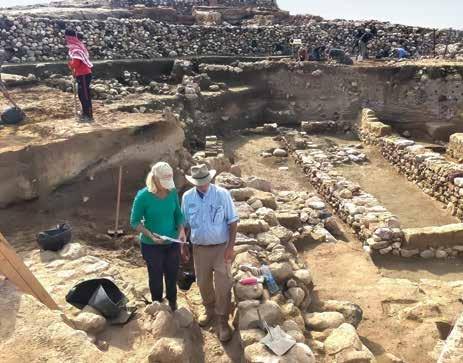
Archaeologists Dr. Carroll Kobs and Dr. Gary Byers survey the foundations of structures at Tall el-Hammam, an enormous ancient city. Its location and circumstances of destruction point to it likely being biblical Sodom.
What had previously been like the Garden of Eden was now a vast, smoldering scene of desolation. Sodom and Gomorrah were gone!
Comet Research Group’s analysis
In 2014, the Comet Research Group (CRG), a non-profit corporation in
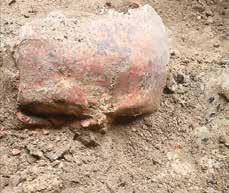
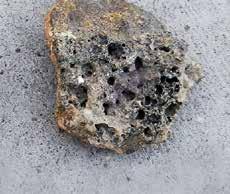
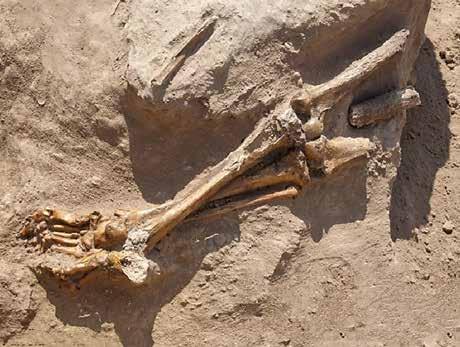
The orange color of this fragment of a human skull was caused by exposure to very high temperatures.
The exterior of this pottery fragment shows melting from exposure to extremely high temperatures.
The leg bones of this victim at Tall el-Hammam show evidence of cataclysmic destruction. The upper body was sheared off at mid-femur, with the ends of the bones burned. The toes curled due to extreme heat at death.
Arizona, was invited to assist in the examination of material evidence from within the destruction layer. The CRG has authored dozens of articles documenting cosmic catastrophes impacting our planet.
The Comet Research Group is not a religious group. It’s made up of comet scientists. The group’s website states: “Think our last space attack was 65,000,000 years ago from the ‘dinosaur-killer’ asteroid? Think again. Killer comets are more common that you’ve been taught. At CRG, our mission is to prove it and to do something about it before your city is next.”
The archaeological history of Tall el-Hammam was well defined after 15 field seasons, but a far different set of skills was needed to properly investigate the destruction layer. The CRG had the technical and forensic ability to determine whether the field evidence supports the biblical description.
Remarkably, the biblical account of destruction from the sky turned out to be supported by numerous lines of geochemical and material evidence buried below the surface of the ground.
Something had demolished the
upper 40-some feet of the four- to fivestory palace structure and blasted away the massive 13-foot-thick mud brick defensive walls of the city. The few skeletal remains showed “fragmentation” and “extreme disarticulation”— meaning the bodies had been violently ripped apart.
A carbon-and-ash-rich destruction layer contained concentrations of shocked quartz, melted pottery and mud bricks, diamond-like carbon, soot, iron- and silicon-rich spherules and spherules from melted plaster. Traces were also found of melted platinum, iridium, nickel, gold, silver, zircon, chromite and quartz.
Heating experiments indicate temperatures must have instantly exceeded 3,600° F (2,000 °C). How hot is that? Enough to turn a truck into a molten pool of iron!
Dr. Allen West of the CRG says of the findings: “Among more technical evidence, we discovered human bones that had been splattered by molten glass from the event. The glass is indistinguishable from that found at ground zero after atomic explosions. These people were killed by the heat and pressure of an atomic-like explosion but without the radiation” (emphasis added throughout).
Narrowing the possibilities
Dr. Silvia has produced 14 lines of evidence that support this site as being the location for the ancient city of Sodom. The paper is available for free download from Nature Scientific Reports (at nature.com/articles/ s41598-021-97778-3).
Key finds of the scientific study done at Tall el-Hammam are documented in the research paper—along with graphs, charts, equations and analysis—showing why the site of Tall el-Hammam could very well be the destruction site of ancient Sodom. Some of the key finds include: • Evidence for high-temperature burning of the city. • Melted construction materials. • Minerals and materials subjected to extremely high pressure and temperatures. • Human bone fragments in the destruction layer. • High salt content of the soil associated with the destruction and its implications for agriculture in the region. • Destruction and burning of nearby Jericho at the same time. • Potential causes of the city destruction.
The scientists looked at 10 different ways this city could have been destroyed, including warfare, accidental fires, earthquakes, volcanism and lightning. Some of the evidence fits some of the possibilities. But all of the evidence appears to fit only a single option—a cosmic airburst, namely a nearby comet or meteor explosion that obliterated the city and its surroundings.
The group concluded that the closest similar destruction events in modern history were the first atomic bomb test in 1945 in New Mexico as part of the World War II Manhattan Project (with an explosive yield of 21,000 tons of TNT) and the 1908 Tunguska cosmic airburst, which flattened 830 square miles of Siberian forest with a similar explosive force.
The blast that destroyed the city at Tall el-Hammam is thought to be a Tunguska-class comet or meteor airburst that exploded near the northern end of the Dead Sea, a few kilometers southwest of the site.
This event was so destructive that all across the lower Jordan Valley, 15 other cities and more than 100 smaller villages were simultaneously abandoned at this time and remained largely uninhabited forapproximately 300 to 600 years, pointing to the occurrence of a rare and highly unusual catastrophic event.
Evidence for destruction not from this world
As previously noted, more than 20 scientists and researchers from many fields contributed to the major paper analyzing the destruction of the large and thriving city at the Tall el-Hammam site almost 4,000 years ago. What did they learn? Some of this is highly technical, but we’ll summarize.
To quote the research paper, “An early crucial clue in this investigation was the discovery of highly vesicular potsherds in the debris matrix that appeared to have melted at high temperatures but with no clear evidence for a formation mechanism” (pp. 56-57).
Translation: They found broken clay pottery—common at such ancient sites—but this pottery had been subjected to such high temperatures that it had melted and formed bubbles, with no clear evidence of what could have produced such extremely high temperatures.
Continuing in the paper: “This first discovery led to some general observations about the uniqueness of destruction layer debris, e.g., its unusual, high-temperature characteristics and its consistent SW-to-NE orientation. The site excavators speculated that the cause of the destruction may have been a cosmic airburst/impact, but they could not eliminate other potential mechanisms, including those related to warfare, volcanism, and tectonism.”
Translation: The debris in the destruction layer was unusual not only for its having been subjected to extremely high temperatures, but also because it was thrown down in a specific direction—from the southwest to the northeast, indicating the destructive force originated in the air southwest of the city (near the northern end of the Dead Sea).
“We investigated 14 major lines of evidence to investigate this unusual event: (i) shocked quartz grains that formed at pressures of ~5–10 GPa; (ii) vesicular pottery that melted at>1500°C; (iii) mudbricks and roofing clay that melted at >1400°C; (iv) high salt concentrations in sediment, including melted KCl and NaCl incorporated into melted mudbricks; (v) diamond-like carbon (diamonoids) that formed at high pressure and temperature; (vi) soot, charcoal and ash, indicating high-temperature fires; (vii) Fe- [iron-] and Si- [silicon-] rich spherules, some of which melted at >1590°C; (viii) platinum, melted at ~1768°C; (ix) iridium at ~2466°C; (x) zircon at
>1687°C; (xi) chromite at >1590°C; (xii) titanomagnetite at >1550°C; (xiii) quartz at 1713°C; and (xiv) low remanent magnetism, a counter-indicator of lightning strikes.”
Translation: They examined 14 lines of evidence for the city’s destruction, including quartz grains and carbon that had been subjected to such immense heat and pressure that their microscopic structure had been deformed and transformed into a completely different form; soot and ash that resulted from high-temperature fires; pottery and construction materials that had melted at temperatures of more than 2700°F; inexplicably high salt content in the soil; and tiny spheres of rare elements and minerals that had melted at temperatures of 2800 to 3100°F (well above the melting temperature of iron and steel).
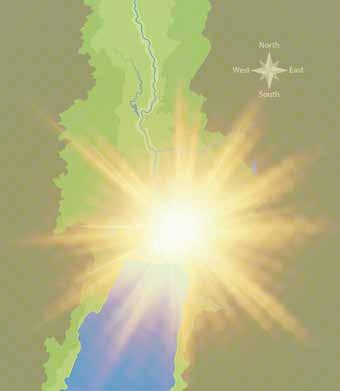
Jordan Valley
Jericho
Tall el-Hammam
Dead Sea
The city that existed at Tall el-Hammam—thought to be ancient Sodom—was apparently destroyed by a meteor or comet that exploded near the northern end of the Dead Sea, producing the fire from the sky described in the biblical account.
“We considered and dismissed 8 of 10 potential processes . . . including volcanism, warfare, and tectonism, that can account for at least some but not all of the evidence. We conclude that the only plausible formation mechanism that can account for the entire range of evidence . . . is a crater-forming impact or a cosmic airburst, most likely somewhat larger than the 22-megaton airburst at Tunguska, Siberia in 1908.”
Translation: They considered 10 different scenarios to account for the destruction evidence at the site and eliminated all but two. The only two possibilities left that could account for the evidence were a comet or meteor that impacted the ground or exploded in the air nearby.
“The data also suggest an airburst occurred a few kilometers SW of Tall el-Hammam causing, in rapid succession, a high-temperature thermal pulse from the fireball
that melted exposed materials, including roofing clay, mudbricks, and pottery. This was followed by a hightemperature, hypervelocity blast wave that demolished and pulverized mudbrick walls across the city, leveling the city, and causing extensive human mortality.”
Translation: The evidence indicates that a comet or meteor exploded in the air near the northern end of the Dead Sea southwest of the city, generating a flash of heat in the thousands of degrees Fahrenheit, melting mud bricks (the city’s primary construction material), clay roofing material and pottery. A secondary high-temperature, high-speed pressure wave pulverized and leveled the city, killing everyone in it.
“In addition, anomalously high salt content in the debris matrix is consistent with an aerial detonation above high-salinity sediments near the Jordan River or above the hypersaline Dead Sea. This event, in turn, distributed salt across the region, severely limiting regional agricultural development for up to ~600 years.”
Translation: Abnormally high salt content in the destruction layer and across the area for miles around led researchers to conclude that an aerial blast vaporized a large volume of water from the high-salt-content Dead Sea. That salt, with other minerals from the Dead Sea, later settled out over the land in such a heavy concentration that raising crops—and thus human habitation—was almost impossible for the next several centuries.
A message of warning and repentance
With all that has been discovered at this site, and with all that has been documented regarding its destruction, what if this is the location of ancient Sodom, Gomorrah and the surrounding towns? What if Sodom has been found? But there’s an even more important question: What if our world is returning to Sodom? What are the lessons for us today? Beyond Today magazine exists to proclaim to the world the good news of the coming Kingdom of God (Matthew 28:1920; 24:14). We have been commanded to preach the gospel to the world, and in particular to the modern-day descendants of ancient Israel. That includes the United States, Canada, Great Britain, Australia and New Zealand. (Most people assume the Israelites today are only the Jewish people and those in the tiny Mideast nation of Israel, but that is not the case—read our eyeopening study guide The United States and Britain in Bible Prophecy to learn more.)
What if they won’t listen and repent? What if they won’t hear?
Notice the commission Jesus Christ gave to His apostles in Matthew 10: “Jesus sent out the twelve apostles with these instructions: ‘Don’t go to the Gentiles or the Samaritans, but only to the people of Israel—God’s lost sheep . . . If any household or town refuses to welcome you or listen to your message, shake its dust from your feet as you leave. I tell you the truth, the wicked cities of Sodom and Gomorrah will be better off than such a town on the judg-
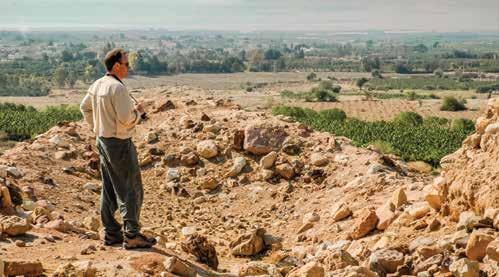
Beyond Today TV presenter and senior writer Darris McNeely looks out over the Jordan Valley from Tell al-Hammam. The message of Sodom is one that calls for repentance. We must not get caught up in a world which grows more like Sodom by the day. Destruction awaits those who will not repent.
ment day” (verses 5-6, 14-15, New Living Translation).
Many secular historians and scientists would dispute any claim for the literal existence of Sodom, insisting the biblical story is a myth, in spite of the many geographic clues contained within the Bible. And many still would deny it even in the face of new evidence.
Even many who claim to be Christians doubt stories of divine judgment like that of Sodom. But if Sodom were nothing but a myth, why would Jesus Himself use it as a warning?
Sodom is mentioned nine times in the New Testament, most often by Jesus Himself. Why would He talk about a place that never existed and that was never destroyed supernaturally? That makes no sense. We have to conclude that Sodom was a real place at a real time with real sins.
And as we see in Matthew 10, why is the example of Sodom put alongside proclaiming the good news of the Kingdom of God?
The answer is simple. A key component of that message is repentance—changing who and what we are so that we can be a part of that Kingdom. Notice how Mark summarizes Jesus Christ’s message in Mark 1:14-15: “Jesus came to Galilee, preaching the gospel of the kingdom of God, and saying, ‘The time is fulfilled, and the kingdom of God is at hand. Repent, and believe in the gospel.’”
We cannot separate those two elements of the message Jesus Christ brought. He is the King of the Kingdom, a Kingdom He will return to earth to establish throughout the world (see our free study guide The Gospel of the Kingdom). But for us to be a part of that Kingdom, we must “repent . . . and be converted, that your sins may be blotted out” (Acts 3:19).
A world returning to Sodom
The ruins of Sodom stand as a stark warning to the people of our world today. They are a sobering reminder of the consequences of sin.
Do you think God is pleased with our world? What must He think of the modern English-speaking nations whose ancestors widely distributed the Bible to the world and based their societies, laws and culture on it?
What must He think of the millions of lives these same nations have murdered in the womb? What does He think of our sexual revolution? What about the confusing versions and redefinitions of gender beyond the male and female He created? (Genesis 1:27; 5:2; Matthew 19:4; Mark 10:6). What about our broken marriages, high crime, drugs, broken-down cities, murder and dying respect for laws and the value of life?
Are we returning to Sodom? Have we already returned to Sodom? Look at the state of the world around you. We are on the precipice of divine judgment on this world. Notice what Jesus Christ said to the people of His day who witnessed His miracles and heard His message, yet refused to repent and change their lives:
“And you Capernaum, who are exalted to heaven [in their arrogance], will be brought down to Hades [the grave]; for if the mighty works which were done in you had been done in Sodom, it would have remained until this day. But I say to you that it shall be more tolerable for the land of Sodom in the day of judgment than for you” (Matthew 11:23-24).
This should also serve as a dire warning for our endtime generation. We are worse today than ancient Sodom was, as we should know better! Sodom’s destruction was an example for all of us to learn from. (See “Are We Returning to Sodom?” beginning on page 14.)
Jude, half-brother of Jesus Christ, similarly warns us: “Don’t forget Sodom and Gomorrah and their neighboring towns, which were filled with immorality and every kind of sexual perversion. Those cities were destroyed by fire and serve as a warning of the eternal fire of God’s judgment” (Jude 7, NLT).
God’s Word is clear that devastating destruction is coming on our world. Read Jesus Christ’s own words in Matthew 24 and His revelation to the apostle John in the book of Revelation, chapters 6, 8-9 and 12-18. Some of the plagues foretold to strike our planet are like the destruction of Sodom multiplied many times over.
God’s pattern—often repeated in the Bible—is to give words of warning before sending destruction. It would be just like God to give powerful witnesses to the truth and accuracy of His Word as a final witness to the world before His judgment is carried out!
Is Tall el-Hammam the location of Sodom? For now the research and excavations continue. More evidence will come to light. In any case, the message of Sodom is one that calls for repentance, which is our message as well. Each of us must not get caught up in a world which grows more like Sodom by the day. Destruction awaits those who will not repent.
How will you let this affect your mind, your thoughts and your life? Are you actively seeking to live by every word of God in your life (Matthew 4:4), or is God and His Word an inconvenient truth you’d rather ignore?
Will anyone listen? Will you listen? What if Sodom has indeed been found? Will the Word of God be heard? Will you heed? We pray it will be so in your life!
LEARN MORE
Sodom is a stark warning of the high price of sin—an entire city vanished in fiery destruction! God wants us to repent and live—but where do we start? Download or request our free study guide What You Need to Know About Baptism to learn more!






